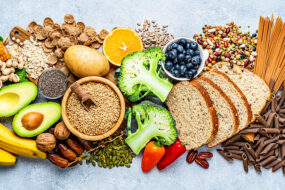What type of yoghurt is healthiest for you?
From creamy Greek to pot-set and dairy-free coconut, yoghurt has come a long way … but they’re not all as good for you as you may think.
Do you know your Skyr from your Greek yoghurt?
Are coconut and lactose-free options only good for those with intolerances?
Is frozen yoghurt healthier than ice cream?
And what should you look for in a healthy yoghurt?
“When it comes to picking a yoghurt, look for one that has a decent hit of protein (>6g per serve), minimal added sugars and provides a good source of calcium,” advises sports dietitian Nicola Jaffrey.
“Lucky for us, there are lots of options out there that tick all of these boxes!”
Health pros and cons of different types of yoghurt
Greek
Greek yoghurt is strained, which results in its thick and creamy consistency.
“The straining process also lowers the lactose content which may help people with sensitive tummies,” says Nicola.
Skyr
Originating from Iceland, skyr (pronounced skeer) has a similar consistency to Greek yoghurt but with a milder flavour.
Just like Greek yoghurt, this variety is high in protein and calcium.
Natural
“Natural yoghurt has a great nutrition profile (usually just milk and cultures) but is often quite tart,” Nicola says.
Want the benefits of high protein and calcium but find it a bit much eaten fresh? Use natural yoghurt to cook or bake with instead.
Sweetened
As the name suggests, this type has sugar or artificial sweeteners added.
This isn’t the healthiest choice of yoghurt, especially if sugar or its substitute is listed high on the ingredients list.
Unfortunately it can be the most appealing to tastebuds, especially for kids – try to choose a more natural option and sweeten at home with fruit or honey.
Coconut
“Coconut yoghurt is calcium-free, low in protein and high in fat; however it is an alternative for people who do not eat animal products,” says dietitian Alex Rutkowska.
Lactose-free
“Lactose-free yogurt contains the same amount of protein, calcium and vitamins A and D as regular milk,” says Alex.
“Unfortunately it is often more processed than regular milk and contains added sugar to replace the natural sugar found in milk (lactose).”
Frozen yoghurt
Often considered a healthier alternative to ice-cream, this can be misleading.
“Frozen yoghurt is a mix of yoghurt with fruit, sugar, colours and flavours, so treat it like a dessert,” advises Alex.
Pot-set
“The method of preparing pot-set yoghurt means that apart from basic ingredients, such as milk and live bacteria cultures, nothing else needs to be added,” says Alex.
“This makes us avoid the thickeners and stabilisers so often added to most yoghurts.”
- Cup of goodness: Which type of milk is best for you?
Experts’ top yoghurt picks
Nicola’s picks for the healthiest options are Greek, Skyr or natural yoghurt, while Alex sticks with natural.
“Try to avoid thickeners and other food additives, as it can often mean a lower quality of the product,” says Alex.
“The same goes for sugar – our diet is high in sugar and we should limit it.”
Nicola says for kids, less is definitely more.
“There are lots of great yoghurts that contain milk, cultures and not much else. Natural or Greek yoghurts are great options for kids and you can add your own fruit or flavours,” she says.
Get your yoghurt fix with these tasty recipes:
- Keto ‘Petit Farcis’ with a Yoghurt Dip
- Apple and Berry Crumble Cups with Yoghurt
- Luke Hines’ Go Greek Salad Jar
Written by Samantha Allemann.





